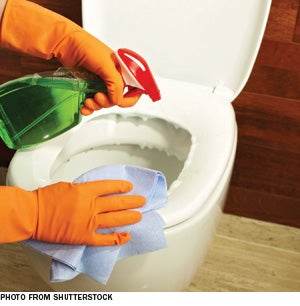Hospital cuts <em>C. diff</em> incidence by 70 percent
 When many hospitals were cutting budgets and positions in areas like environmental services (ES) in 2009 to deal with the Great Recession, Rhode Island Hospital in Providence laid the groundwork for doing the opposite.
When many hospitals were cutting budgets and positions in areas like environmental services (ES) in 2009 to deal with the Great Recession, Rhode Island Hospital in Providence laid the groundwork for doing the opposite.
Infection prevention leaders at the hospital were surveying other regional institutions to learn what items in patient rooms were cleaned daily and who was responsible for cleaning each item. Survey data would be used successfully to educate and help persuade the administration that nine more ES positions were needed.
It was all part of a six-step facilitywide intervention to reduce the incidence of Clostridium difficile. Three years later, these and other earlier efforts contributed to a 70 percent reduction in health care-associated C. diff at the facility. Other actions included developing an infection control plan based on risk assessment, monitoring hospitalwide morbidity and mortality associated with C. diff infections, increasing hand-hygiene compliance, implementing an antimicrobial stewardship program and more.
A detailed account of the study appeared in the July edition of the Joint Commission Journal on Quality and Patient Safety. Leonard A. Mermel, D.O., medical director of the department of epidemiology and infection control at Rhode Island Hospital and a co-author of the paper, notes the value of the multidisciplinary effort.
"By working together to better monitor those patients at risk, enhance the cleaning of patient rooms and equipment, and to use contact precautions as appropriate, we were able to significantly reduce the risk of this virulent infection and, ultimately, to provide better, safer care," Mermel says.
The multistep process based on a risk assessment included: developing and implementing a C. diff infection control plan; monitoring additional data sets, including associated mortality and morbidity as measured by C. diff-related colectomies; improving sensitivity of C. diff toxin detection in stool specimens to reduce false-negative results; and enhancing environmental cleaning of patient rooms and equipment.
Researchers monitored the number of C. diff infections per 1,000 hospital discharges from the second quarter of 2006 to the third quarter of 2012 and found that health care-associated C. diff infections were reduced from a peak of 12.2 per 1,000 discharges in the second quarter of 2006 to 3.6 per 1,000 discharges in the third quarter of 2012.
Some of the steps taken by the hospital's ES team to aid in the C. diff infection control plan included using a hypochlorite-based cleaning agent in all isolation rooms; implementing fluorescent marking pens and ultraviolet light to monitor cleaning thoroughness; developing an equipment cleaning index that detailed who is responsible for cleaning specific items in rooms; adding more full-time equivalents; and enhancing discharge cleaning of all patient rooms.
The researchers concluded that a hospitalwide, multdisciplinary approach can reduce health care-associated C. diff infection morbidity and mortality.


